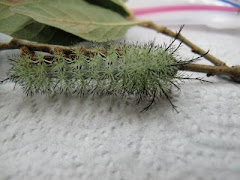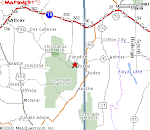


Our last full day. I worked for Angella with Jared and Karen in the lab dissecting caterpillars under the microscope. Angella has been investigating caterpillars' immune response to parasitism by injecting them with tiny, red glass beads, waiting 24 hours, and freezing them. The beads mimic the eggs that wasps and flies deposit into the body of caterpillars. If the caterpillar can, it encapsulates the egg, rendering it harmless. If it can't, the eggs grow and hatch into tiny larvae that feed on the caterpillar as it feeds on plants, eventually emerging from the caterpillars body, and pupating. Perhaps you have seen caterpillars covered with tiny white blobs. The white blobs are the pupae and unfortunately for the caterpillar, when the adult emerges it finishes consuming the caterpillar. When Angella injects the miniscule beads, on the order of 40 - 100 microns, the caterpillar either encapsulates them, or not. If the caterpillar encapsulates the beads, they cover the bead with a dark layer of cells and they no longer appear red. If they can't, the bead stays red. Our job was to carefully dissect the caterpillars, collect the beads and describe their color. Looking at a caterpillar under the microscope was amazing. Their bodies are incredibly detailed inside and out. I spent 81/2 hours glued to the microscope. Angella explained that caterpillars are usually either toxic or have a strong immune system, meaning they are able to encapsulate. Apparently, the toxins that some caterpillars can produce, inhibit their immune system. It appears as though the ability to concentrate plant toxins or encapsulate parasitic eggs is driven by which way the species is attacked, predation or parasitism. Those that are predated upon, evolve toxicity. Those that are parasitized, evolve the ability to encapsulate. In addition, tropical species more often are able to encapsulate while temperate species tend to be toxic. The reason for this discrepancy has to do with the environment in which they live. Tropical rain forests are dense and birds can not see caterpillars so do not eat them. Instead, wasps and flies use their sense of smell to find caterpillars and parasitize them. Temperate forests are more open and birds can see caterpillars and so predate heavily upon them. EIther way, it is a good thing caterpillar densities are controlled. Without parasites or predators our forests would be devastated, compromising the entire forest community. We ended the night with a last night in Cave Creek celebration to the Rodeo Tavern where we had a drink, watched several pool matches, and went on a desert walk where we saw a rare arachnid, the Vinegaroon. On the way back to Cave Creek, we searched the roadway for snakes and with good fortune came across a Mohave Rattler. A great time was had by all.





